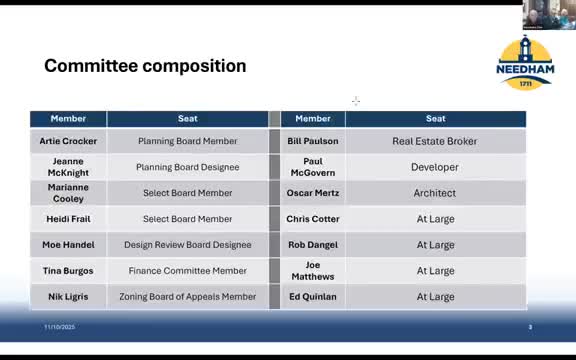Consultant finds modest developer bid reductions under smaller-FAR scenarios; committee urges clearer public framing
November 12, 2025 | Town of Needham, Norfolk County, Massachusetts
This article was created by AI summarizing key points discussed. AI makes mistakes, so for full details and context, please refer to the video of the full meeting. Please report any errors so we can fix them. Report an error »

A consultant's fiscal analysis presented at the Dec. 10 meeting of the Town of Needham’s Large House Review Study Committee estimated that reducing allowable floor‑area ratio (FAR) and other bulk controls could lower the price a developer is willing to pay for a teardown lot by amounts typically in the tens of thousands of dollars.
Committee members described the study’s method: the consultant compared the sale price of an original property with the expected sale price of a newly built house, calculated the delta, and then assumed a 15% developer gross profit to infer how much a developer would pay under smaller replacement houses. "The fiscal report is here tonight in this slide deck," Oscar Mertz said as he introduced the material. The committee emphasized that the consultant’s math is designed to model developer bids; members repeatedly asked to label slides to show the distinction between developer bids and potential impacts to homeowner sellers or end‑user buyers.
The consultant reported median rebuilt‑home sizes and prices used for modeling and a median price per square foot in recent rebuilds of roughly $470 per square foot in the sample. Citing peers, committee members quoted local experience that reductions in other towns produced initial drops ‘‘in the tens of thousands’’ for certain market segments; Jim Kelly of Whitehead was quoted as saying, "the value of those houses will be down... the drop was in tens of thousands of dollars on a house, not hundreds of thousands." Committee members asked staff to soften anecdotal language and to add qualifiers about time windows and market volatility.
Members also discussed buyer‑pool effects: if developers are the marginal buyer on a lot, a reduction in developer appetite can lower the highest bid; but if end‑user buyers compete, prices may respond differently. Ed Quinler cautioned, "I'm really concerned that somebody's at this presentation is gonna see that they're gonna lose $53,000 if we implement these zoning bylaw changes," and the group agreed to make the developer/owner distinction explicit in public materials. The committee asked the consultant to prepare a concise (15–20 minute) public‑facing summary for the upcoming community meeting and to document data assumptions about livable area and basement inclusion.
Committee members described the study’s method: the consultant compared the sale price of an original property with the expected sale price of a newly built house, calculated the delta, and then assumed a 15% developer gross profit to infer how much a developer would pay under smaller replacement houses. "The fiscal report is here tonight in this slide deck," Oscar Mertz said as he introduced the material. The committee emphasized that the consultant’s math is designed to model developer bids; members repeatedly asked to label slides to show the distinction between developer bids and potential impacts to homeowner sellers or end‑user buyers.
The consultant reported median rebuilt‑home sizes and prices used for modeling and a median price per square foot in recent rebuilds of roughly $470 per square foot in the sample. Citing peers, committee members quoted local experience that reductions in other towns produced initial drops ‘‘in the tens of thousands’’ for certain market segments; Jim Kelly of Whitehead was quoted as saying, "the value of those houses will be down... the drop was in tens of thousands of dollars on a house, not hundreds of thousands." Committee members asked staff to soften anecdotal language and to add qualifiers about time windows and market volatility.
Members also discussed buyer‑pool effects: if developers are the marginal buyer on a lot, a reduction in developer appetite can lower the highest bid; but if end‑user buyers compete, prices may respond differently. Ed Quinler cautioned, "I'm really concerned that somebody's at this presentation is gonna see that they're gonna lose $53,000 if we implement these zoning bylaw changes," and the group agreed to make the developer/owner distinction explicit in public materials. The committee asked the consultant to prepare a concise (15–20 minute) public‑facing summary for the upcoming community meeting and to document data assumptions about livable area and basement inclusion.
View the Full Meeting & All Its Details
This article offers just a summary. Unlock complete video, transcripts, and insights as a Founder Member.
✓
Watch full, unedited meeting videos
✓
Search every word spoken in unlimited transcripts
✓
AI summaries & real-time alerts (all government levels)
✓
Permanent access to expanding government content
30-day money-back guarantee

